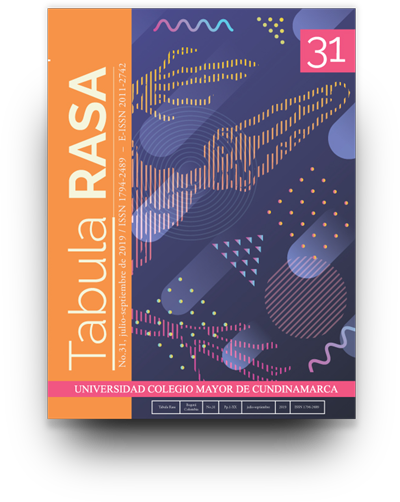"De muchas luchas" : vacas, vaqueros y el proceso de producción de carne al sur de los Estados Unidos.
“Of Many Fights” : cows, cowboys, and meat production in southern United States.
Mostrar biografía de los autores
En este texto rastreo algunos encuentros que acontecen a lo largo de un proceso de la producción de carne bovina de calidad suprema, al sur de los Estados Unidos. Al atender a los encuentros materiales, discursivos, y afectivos en la medida en que estos hacen cuerpos, el texto ofrece una mirada a la producción ganadera en la que esta, más que una secuencia de prácticas dirigidas hacia la producción de carne, se entrevé como una acumulación de contactos, fricciones y rupturas. En este sentido, se plantean una serie de reflexiones sobre las maneras en que se compone la vida y la muerte animal a través de los procesos productivos contemporáneos.
Visitas del artículo 243 | Visitas PDF 72
Descargas
- Alaimo, S. (2013). Sexual matters: Darwinian feminisms and the nonhuman turn. J19: The Journal of Nineteenth-Century Americanists, 1(2), 390–396.
- Blanchette, A. (2018). Industrial Meat Production. Annual Review of Anthropology, 47(1), 185–199. https://doi.org/10.1146/annurev-anthro-102317-050206
- Clark, J. L. (2012). Ecological Biopower, Environmental Violence Against Animals, and the “Greening” of the Factory Farm. Journal for Critical Animal Studies, 10(4), 109–129.
- Coppin, D. (2003). Foucauldian Hog Futures: fte Birth of Mega-Hog Farms. The Sociological Quarterly, 44(4), 597–616.
- Dias, L. S., Hadlich, J. C., Luzia, D. M. M., & Jorge, N. (2016). Influence of breed on beef and intramuscular fat quality from nellore (Bos indicus) and wagyu (Bos taurus) crossbreed cattle. International Food Research Journal; Selangor, 23(4), 1523–1530.
- Drouillard, J. S. (2018). Current situation and future trends for beef production in the United States of America—A review. Asian-Australasian Journal of Animal Sciences, 31(7), 1007.
- Galvin, S. S. (2018). Interspecies Relations and Agrarian Worlds. Annual Review of Anthropology, 47(1), 233–249.
- Greene, C., Ferreira, G., Carlson, A., Cooke, B., & Hitaj, C. (2017). Growing organic demand provides high-value opportunities for many types of producers. USDA Recuperado de: https://www.ers.usda.gov/amber-waves/2017/januaryfebruary/growing-organic-demand-provides-high-value-opportunities-for-many-types-of-producers/
- Haraway, D. J. (2007). When Species Meet. Minneapolis: University Of Minnesota Press.
- Haraway, D. J. (2016). Staying with the Trouble: Making Kin in the Chthulucene. Durham: Duke University Press.
- Hayes, D., & Hayes, G. B. (2015). Cowed: The Hidden Impact of 93 Million Cows on America’s Health, Economy, Politics, Culture, and Environment. New York: W. W. Norton & Company.
- Heidegger, M. (1927). Being and Time. New York: Harper Perennial Modern Classics.
- Holt, R., Hernes, T., Helin, J., & Hjorth, D. (2016). Process is how process does. En J. Helin, T. Hernes, D. Hjorth, & R. Holt (Eds.), The Oxford Handbook of Process Philosophy and Organization Studies (pp. 1–16). Oxford: Oxford University Press.
- Imhoff, D. (Ed.). (2010). The CAFO Reader: The Tragedy of Industrial Animal Factories. Healdsburg, Calif. : Berkeley: Watershed Media.
- Jackson, J. (2006). Los Mesteños: Spanish Ranching in Texas, 1721-1821. Texas: Texas A&M University Press.
- Jarvis, B. F., & Song, X. (2017). Rising Intragenerational Occupational Mobility in the United States, 1969 to 2011. American Sociological Review, 82(3), 568–599.
- Jordan, T. G. (1981). Trails to Texas: Southern Roots of Western Cattle Ranching. Lincoln: University of Nebraska Press.
- Jordan-Bychkov, T. G., & Jordan, T. G. (1993). North American Cattle-Ranching Frontiers: Origins, Diffusion and Differentiation. Albuquerque: University of New Mexico Press.
- Kirby, D. (2011). Animal Factory: The Looming Threat of Industrial Pig, Dairy, and Poultry Farms to Humans and the Environment. New York: St. Martin’s Griffin.
- Kohn, E. (2007). How dogs dream: Amazonian natures and the politics of transspecies engagement. American Ethnologist, 34(1), 3–24.
- Law, J. (2004). After Method: Mess in Social Science Research (1 edition). London ; New York: Routledge.
- Lemke, T., Casper, M. J., & Moore, L. J. (2011). Biopolitics: An Advanced Introduction. New York: NYU Press.
- Niman, N. H. (2014). Defending Beef: The Case for Sustainable Meat Production. White River Junction, Vermont: Chelsea Green Publishing.
- Ogle, M. (2013). In Meat We Trust: An Unexpected History of Carnivore America. Boston: Houghton Mifflin Harcourt.
- Pace, R. F., & Frazier, D. D. S. (2012). Frontier Texas: History of a Borderland to 1880. Texas: State House Press.
- Ribas, V. (2015). On the Line: Slaughterhouse Lives and the Making of the New South. Oakland: University of California Press.
- Schwartz, J. D., & Ehrlich, G. (2013). Cows Save the Planet: And Other Improbable Ways of Restoring Soil to Heal the Earth. (L. Jorstad, Ed.). White River Junction: Chelsea Green Publishing.
- Specht, J. (2019). Red Meat Republic: A Hoof-to-Table History of How Beef Changed America. Princeton, Princeton University Press.
- Stewart, K. (2017). In the World that Affect Proposed. Cultural Anthropology, 32(2), 192–198.
- Striffler, S. (2007). Chicken: The Dangerous Transformation of America’s Favorite Food. New Haven: Yale University Press. ftompson, E. P. (1967). Time, Work-Discipline, and Industrial Capitalism. Past & Present, (38), 56–97.
- Tsing, A. L. (2015). The Mushroom at the End of the World: On the Possibility of Life in Capitalist Ruins. Princeton: Princeton University Press.
- USDA. (2014). 2012 Census of Agriculture. Summary and State Data. Washington, D.C.: U.S. Department of Agriculture’s National Agricultural Statistics Service.
- USDA. (2016). 2012 Census of Agriculture. Organic Survey (20 14 ). Washington, D.C.: U.S. Department of Agriculture’s National Agricultural Statistics Service.




